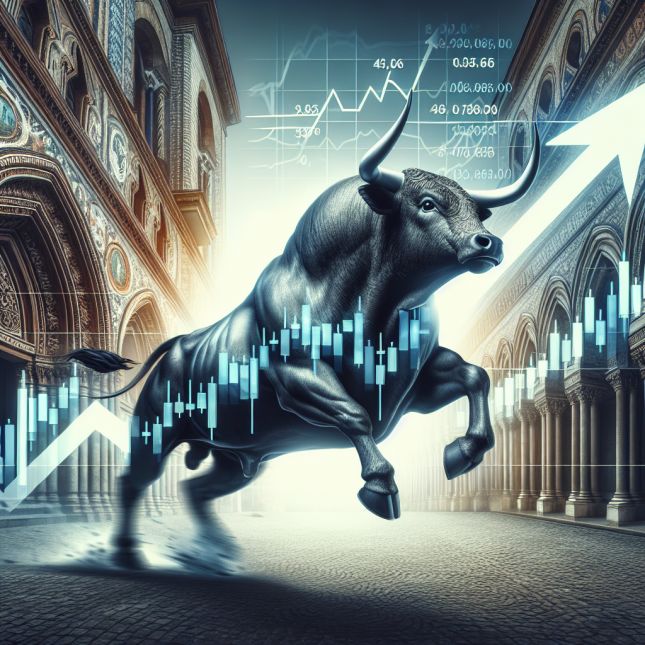
Dec 8, 2024
Introduction: Dancing with the Devil in the Details – The NASDAQ Enigma
Welcome to the wild, wild world of the NASDAQ Composite, a market enigma that defies conventional wisdom and keeps investors on their toes. This isn’t your average stock market index; it’s a technological beast with a rebellious streak a mile wide. The NASDAQ is where fortunes are made and lost, ancient wisdom clashes with modern mayhem, and the rules are written in code and executed with lightning speed.
As we embark on this rollercoaster ride, buckle up and prepare for a journey through the intersection of market psychology, philosophical insights, and the disruptive forces that shape our world. The NASDAQ Composite isn’t just a barometer of the tech sector’s health; it reflects our insatiable appetite for innovation and a challenge to the status quo.
The NASDAQ Composite is more than just a collection of stocks; it’s a battlefield where bulls and bears clash, driven by the same forces that fueled the ancient Silk Road and continue to power today’s digital revolution. It’s a place where the laws of human nature hold sway, and the ability to adapt and anticipate is the difference between success and failure.
We’re about to dive into the devilish details of the NASDAQ Composite, where every trade is a dance with destiny, and the only certainty is uncertainty. Let the games begin, and may the odds be ever in your favor.
Current Trading Levels and Recent Trends
As of April 2024, the NASDAQ Composite is trading at approximately 14,500 points, a significant recovery from the lows experienced during the COVID-19 pandemic. On March 23, 2020, the index fell to 6,860.67 points, its lowest level since 2014. However, the NASDAQ Composite has since rebounded strongly, gaining nearly 111% from its pandemic low to its current level.
This impressive recovery can be attributed to the resilience of the technology sector, which has thrived amidst the accelerated digital transformation brought about by the global health crisis. Many NASDAQ-listed companies, such as Amazon, Netflix, and Zoom, have benefited from the shift towards e-commerce, streaming entertainment, and remote work.
According to recent data from the NASDAQ, the index has experienced an average annual growth rate of 12% over the past five years, outpacing the broader market. The S&P 500, a benchmark index for the U.S. stock market, has generated an average annual return of 9.2% over the same period.
The NASDAQ Composite’s strong performance can also be seen in its year-to-date gains. As of April 2024, the index has risen by 8.5% since the beginning of the year, driven by the continued strength of the technology sector and the gradual reopening of the global economy.
However, it is essential to note that the NASDAQ Composite’s rapid growth has also raised concerns about potential overvaluation in the technology sector. The index’s price-to-earnings ratio, a key valuation metric, currently stands at 35.6, well above its historical average of 24.1. This elevated valuation suggests that investors may be pricing in significant future growth for NASDAQ-listed companies, leaving the index vulnerable to a correction if these expectations are unmet.
The Wisdom of Ancient Philosophers
To fully comprehend the NASDAQ Composite’s behaviour, it is essential to draw upon the wisdom of ancient philosophers. Lao Tzu, the legendary Chinese philosopher who lived around the 6th century BC, once said, “The journey of a thousand miles begins with a single step.” This adage holds for investors in the NASDAQ Composite, as the index’s long-term success is built upon the cumulative effect of countless individual investment decisions.
Lao Tzu’s Taoist philosophy emphasizes harmony and balance, principles that are equally applicable to the stock market. Just as the natural world seeks equilibrium, the NASDAQ Composite’s performance is influenced by the delicate interplay between supply and demand, fear and greed, and innovation and obsolescence.
The Insights of Modern Thinkers
Shifting our focus to more recent times, the renowned philosopher and mathematician Bertrand Russell, who lived from 1872 to 1970, offers valuable insights into the nature of human behaviour and its impact on financial markets. In his book “The Conquest of Happiness,” Russell argues that pursuing material wealth often leads to a sense of emptiness and dissatisfaction. This observation is particularly relevant to the NASDAQ Composite, as the index is heavily weighted towards technology companies, many of which are driven by the relentless pursuit of growth and market dominance.
Russell’s philosophy reminds us that the true value of an investment lies not only in its financial returns but also in its ability to contribute to society’s greater good. As investors assess the merits of various NASDAQ-listed companies, they must consider their short-term profitability and long-term impact on the world.
The Wisdom of Legendary Traders
To further enrich our understanding of the NASDAQ Composite, we turn to the philosophies and methodologies of two legendary traders from the past 2,000 years. First, let us consider the teachings of Jesse Livermore, the famous American trader who lived from 1877 to 1940. Livermore’s approach to trading was rooted in the belief that markets are driven by human emotions, particularly fear and greed. He famously stated, “The market is never wrong; opinions often are.”
Livermore’s emphasis on market psychology is particularly relevant to the NASDAQ Composite, as the index is often subject to the whims of investor sentiment. During periods of euphoria, such as the dot-com bubble of the late 1990s, the NASDAQ Composite can experience rapid and unsustainable growth, only to come crashing down when reality sets in. Conversely, during times of fear and uncertainty, such as the early stages of the COVID-19 pandemic, the index can plummet, presenting savvy investors with opportunities to buy undervalued stocks.
Next, we examine the philosophy of Nicolas Darvas, the Hungarian-born dancer turned investor who made a fortune trading stocks in the 1950s and 1960s. Darvas’ approach to investing was based on the concept of momentum, the idea that stocks that have been rising in price are likely to continue. At the same time, those falling are likely to continue their downward trajectory.
Darvas’ momentum-based strategy particularly applies to the NASDAQ Composite, as the index is home to many high-growth technology stocks that can experience rapid price appreciation. However, as Darvas himself cautioned, momentum can be a double-edged sword, and investors must be prepared to cut their losses quickly when a stock’s upward trajectory reverses.
The Psychology of Market Movements
To fully comprehend the NASDAQ Composite’s behaviour, it is essential to consider the psychological factors that drive market movements. One such phenomenon is the bandwagon effect, which refers to individuals’ tendency to follow the crowd, even when doing so goes against their better judgment.
In the context of the NASDAQ Composite, the bandwagon effect can manifest itself in the form of herd mentality, as investors rush to buy or sell stocks based on the actions of others rather than on their analysis of the underlying fundamentals. This behaviour can lead to the formation of speculative bubbles, as seen during the dot-com era, when the NASDAQ Composite reached an all-time high of 5,048.62 on March 10, 2000, only to lose nearly 80% of its value over the next two years.
Another psychological factor influencing the NASDAQ Composite’s performance is contrarian investing, which involves taking a position opposite to the prevailing market sentiment. Contrarian investors seek to profit from stock mispricing that can occur when the market becomes overly pessimistic or optimistic.
For example, during the early stages of the COVID-19 pandemic, when the NASDAQ Composite experienced a sharp sell-off, contrarian investors may have seen an opportunity to buy undervalued technology stocks, betting that the sector would rebound as the world adapted to the new reality of remote work and digital communication.
Technical Analysis and the NASDAQ Composite
Finally, no discussion of the NASDAQ Composite would be complete without considering the role of technical analysis in predicting the index’s movements. Technical analysis involves studying past price and volume data to identify patterns and trends that can provide insight into future market behaviour.
One commonly used technical indicator is the moving average, which smooths out short-term price fluctuations to reveal underlying trends. For the NASDAQ Composite, the 50-day and 200-day moving averages are often used as key support and resistance levels, with a break above or below these levels signalling a potential change in market direction.
Another crucial technical concept is the relative strength index (RSI), which measures the magnitude of recent price changes to determine whether a stock or index is overbought or oversold. When the NASDAQ Composite’s RSI rises above 70, it may indicate that the index is overbought and due for a correction, while an RSI below 30 may suggest that the index is oversold and poised for a rebound.
Conclusion– Dancing with the NASDAQ Devil
The NASDAQ Composite isn’t for the faint of heart—it’s a wild ride through the depths of human ambition and innovation. It’s where ancient wisdom collides with modern mayhem, creating a market maelstrom that challenges even the most seasoned investors. This isn’t your grandfather’s stock market; it’s a technological revolution fueled by the relentless pursuit of progress.
We navigate this infinite game with a swagger and a rebel’s spirit. The NASDAQ isn’t just about charts and numbers; it’s a psychological battleground where the legends of trading, from Jesse Livermore to George Soros, have left their mark. Their wisdom is our battle cry, reminding us that adaptability is the name of the game.
In this arena, we embrace the disruptive forces that shape our world. We challenge assumptions, question conventional wisdom, and think like philosophers, psychologists, and rogue strategists rolled into one. The NASDAQ isn’t just a collection of stocks; it reflects our insatiable desire to push boundaries and break the mould.
The secrets to success in this game aren’t found in stale, conventional strategies. They lie in the intersection of ancient insights and forward-thinking approaches. It’s about recognizing that human nature is the constant in an ever-changing technological landscape. We must be like water, adapting to the tech sector’s ever-evolving nature and identifying trends before they become mainstream.
This isn’t a game for the timid. It takes courage to dance with the NASDAQ devil. But the rewards are immense for those bold enough to embrace the challenge. By integrating the wisdom of the ages with a relentless focus on the future, we position ourselves not just to react but to anticipate. We become market mavericks, riding the waves of change and capitalizing on opportunities others do not imagine.
As we embark on this wild ride, let’s raise a middle finger to the status quo and embrace the infinite game with open arms. Let the legends of the past be our guide, the present be our playground, and the future be our canvas to create something extraordinary.
In the words of a modern-day maverick: “If you’re not willing to look like a fool, you’ll never have the chance to be brilliant.” So, strap in, challenge conventions, and join the revolution. The NASDAQ Composite isn’t just an index—it’s a force of nature, and we’re here to dance with the devil himself.
Let the market mayhem begin.










